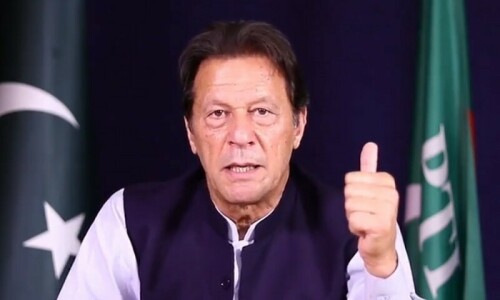AT a press conference called to tout the government’s achievement in stabilising the economy, and to announce the first stimulus measures since the period of adjustment began, the prime minister’s financial adviser, Hafeez Shaikh, found himself peppered, instead, with questions about the rise in prices of essential items.
Read: PM aide on finance chastised over price hike ignorance
Rarely has a government official found himself so much at sea in trying to field questions of such intimate importance to ordinary people.
When the responses given by Mr Shaikh sounded too vacuous, the questions became more pointed, ending, ultimately, with one reporter asking about the massive spike in the price of tomatoes, to which the adviser famously responded that, as per his information, tomatoes were selling for Rs17 per kilo in Karachi’s wholesale vegetable markets.
Rarely has so much been said in so few words.
In that one fleeting moment, videos of which went viral in a matter of minutes and made Mr Shaikh the target of derision around the country, we all saw the immense gulf that separates the rulers from the ruled in this country.
It is entirely possible that many of our worthy policymakers have hardly ever gone to the market to purchase tomatoes. It is equally possible that they are largely indifferent to the impact that the food price hikes have on the daily lives of tens of millions of people in this country, who have no choice but to spend more than half their household income on food for their family.
But surely, our decision-makers should look beyond their mandate to fix the deficits in the economy and “create buffers”, to use the soulless parlance of the IMF, in the fiscal equation as well as the foreign exchange reserves.
Surely, they should not be indifferent to how their policies will impact the population even as the financial managers try to correct the economic flaws.
Meanwhile, the macroeconomic stability that Mr Shaikh wants to underscore has actually been earned on the backs of the working and unemployed poor of this country. It is they who have made the heaviest sacrifice in the government’s slash-and-burn economic stabilisation effort thus far, and who have felt the greatest pain of these ‘demand compression’ policies.
Yet, once the buffers are created, and fiscal resources become available, they are to be spent on the rich first and foremost, in the old-fashioned hope that from there the wealth will trickle down to the poor. This is how Mr Shaikh was able to announce that Rs200bn will be spent to subsidise interest rates on loans for exporters, and Rs30bn would be similarly spent on loans for construction magnates. But for the poor, we see a package worth Rs6bn to be spent through the utility stores to make essential items affordable. The disparity is unmistakable, as is the terrible injustice behind it all.
Published in Dawn, November 13th, 2019











































